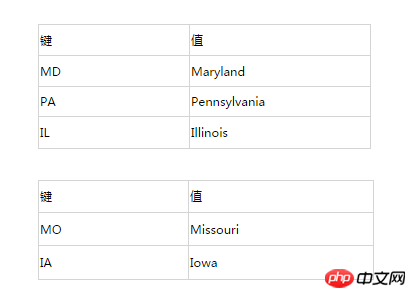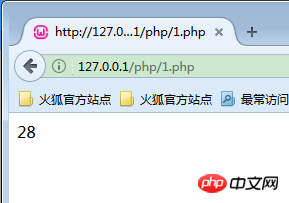Types of PHP arrays - associative arrays
Types of PHP arrays - associative array
What is an associative array in PHP?
In the previous article, we introduced "Types of PHP arrays-numeric index array". Today we will introduce associative arrays in detail.
In addition to array index arrays, PHP also has an associative array. In other computer languages, it is generally called hash or map
Using associative arrays, we can specify a keyword for each array element , we call it key

$info = [ 'name' => 'andy', 'age' => 18, 'gender' => 'male'];
is equivalent to
$info = array( 'name' => 'andy', 'age' => 18, 'gender' => 'male');
It is impossible to obtain data using numerical subscripts in associative arrays, such as $info[ 0] is empty, we need to use the key as the subscript. The value of $info['age'] is 18.
The key names of associative arrays can be a mixture of numbers and strings, unlike the key names of numeric index arrays which can only be numbers. In an array, as long as one of the key names is not a number, then the array is called an associative array.
Associative arrays are similar to arrays and consist of fields and methods with names as keys.
It contains scalar data, which can be selected individually by index value. Unlike arrays, the index value of an associative array is not a non-negative integer but an arbitrary scalar. These scalars are called Keys and can later be used to retrieve values in the array.
The elements of an associative array are in no particular order, you can think of them as a set of cards. The upper half of each card is the index and the lower half is the numerical value.
The essence of a JavaScript object is an associative array.
Associative arrays (associative arrays) use string indexes (or keys) to access the values of each element stored in the array. The key values are as shown in the following table. Associatively indexed arrays are useful for database layer interactions.

Associative array case is as follows:
<?php
$newarray=array("first"=>1,"second"=>2,"third"=>3);
echo $newarray["second"];
$newarray["third"]=8;
echo $newarray["third"];
?>The output result is:

Tip: The key name of the associative array can be any integer or string. If the key name is a string, don’t forget to add a delimiter to the key name or index—single quote (') or double quote ("). For numeric index arrays, in order to avoid unnecessary trouble, we also recommend It’s better to add delimiters!
In the next article, we will explain "PHP Array Types-Multidimensional Arrays"!
[Related Tutorial Recommendations]
Recommended related topics: "php array (Array)"
Recommended related video courses:
《Use for loop to traverse arrays: index and associative array》
《 Use while loop to traverse arrays: index and associative array》
《Use foreach loop to traverse: index and associative array》
The above is the detailed content of Types of PHP arrays - associative arrays. For more information, please follow other related articles on the PHP Chinese website!

Hot AI Tools

Undresser.AI Undress
AI-powered app for creating realistic nude photos

AI Clothes Remover
Online AI tool for removing clothes from photos.

Undress AI Tool
Undress images for free

Clothoff.io
AI clothes remover

Video Face Swap
Swap faces in any video effortlessly with our completely free AI face swap tool!

Hot Article

Hot Tools

Notepad++7.3.1
Easy-to-use and free code editor

SublimeText3 Chinese version
Chinese version, very easy to use

Zend Studio 13.0.1
Powerful PHP integrated development environment

Dreamweaver CS6
Visual web development tools

SublimeText3 Mac version
God-level code editing software (SublimeText3)

Hot Topics
 1677
1677
 14
14
 1431
1431
 52
52
 1334
1334
 25
25
 1280
1280
 29
29
 1257
1257
 24
24
 The Continued Use of PHP: Reasons for Its Endurance
Apr 19, 2025 am 12:23 AM
The Continued Use of PHP: Reasons for Its Endurance
Apr 19, 2025 am 12:23 AM
What’s still popular is the ease of use, flexibility and a strong ecosystem. 1) Ease of use and simple syntax make it the first choice for beginners. 2) Closely integrated with web development, excellent interaction with HTTP requests and database. 3) The huge ecosystem provides a wealth of tools and libraries. 4) Active community and open source nature adapts them to new needs and technology trends.
 What happens if session_start() is called multiple times?
Apr 25, 2025 am 12:06 AM
What happens if session_start() is called multiple times?
Apr 25, 2025 am 12:06 AM
Multiple calls to session_start() will result in warning messages and possible data overwrites. 1) PHP will issue a warning, prompting that the session has been started. 2) It may cause unexpected overwriting of session data. 3) Use session_status() to check the session status to avoid repeated calls.
 The Compatibility of IIS and PHP: A Deep Dive
Apr 22, 2025 am 12:01 AM
The Compatibility of IIS and PHP: A Deep Dive
Apr 22, 2025 am 12:01 AM
IIS and PHP are compatible and are implemented through FastCGI. 1.IIS forwards the .php file request to the FastCGI module through the configuration file. 2. The FastCGI module starts the PHP process to process requests to improve performance and stability. 3. In actual applications, you need to pay attention to configuration details, error debugging and performance optimization.
 What is the significance of the session_start() function?
May 03, 2025 am 12:18 AM
What is the significance of the session_start() function?
May 03, 2025 am 12:18 AM
session_start()iscrucialinPHPformanagingusersessions.1)Itinitiatesanewsessionifnoneexists,2)resumesanexistingsession,and3)setsasessioncookieforcontinuityacrossrequests,enablingapplicationslikeuserauthenticationandpersonalizedcontent.
 Composer: Aiding PHP Development Through AI
Apr 29, 2025 am 12:27 AM
Composer: Aiding PHP Development Through AI
Apr 29, 2025 am 12:27 AM
AI can help optimize the use of Composer. Specific methods include: 1. Dependency management optimization: AI analyzes dependencies, recommends the best version combination, and reduces conflicts. 2. Automated code generation: AI generates composer.json files that conform to best practices. 3. Improve code quality: AI detects potential problems, provides optimization suggestions, and improves code quality. These methods are implemented through machine learning and natural language processing technologies to help developers improve efficiency and code quality.
 Using Laravel: Streamlining Web Development with PHP
Apr 19, 2025 am 12:18 AM
Using Laravel: Streamlining Web Development with PHP
Apr 19, 2025 am 12:18 AM
Laravel optimizes the web development process including: 1. Use the routing system to manage the URL structure; 2. Use the Blade template engine to simplify view development; 3. Handle time-consuming tasks through queues; 4. Use EloquentORM to simplify database operations; 5. Follow best practices to improve code quality and maintainability.
 PHP and IIS: Making Them Work Together
Apr 21, 2025 am 12:06 AM
PHP and IIS: Making Them Work Together
Apr 21, 2025 am 12:06 AM
Configuring and running PHP on IIS requires the following steps: 1) Download and install PHP, 2) Configuring IIS and adding FastCGI module, 3) Create and set up an application pool, 4) Create a website and bind to an application pool. Through these steps, you can easily deploy PHP applications on your Windows server and improve application stability and efficiency by configuring scaling and optimizing performance.
 H5: Key Improvements in HTML5
Apr 28, 2025 am 12:26 AM
H5: Key Improvements in HTML5
Apr 28, 2025 am 12:26 AM
HTML5 brings five key improvements: 1. Semantic tags improve code clarity and SEO effects; 2. Multimedia support simplifies video and audio embedding; 3. Form enhancement simplifies verification; 4. Offline and local storage improves user experience; 5. Canvas and graphics functions enhance the visualization of web pages.




